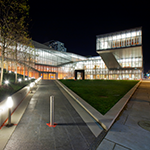Austrian-born architect Friedrich St.Florian has taught and practiced architecture for more than half a century, but he is perhaps best known for one project: the National World War II Memorial in Washington, DC. Ten years after the opening of that project, his firm, Friedrich St.Florian Architects, continues to pursue heritage work, including, recently, the design of the Michigan-based Agricultural Awareness & Preservation Museum and the planning of a headquarters for an import company on a historic farm in Connecticut. Here, St.Florian returns to the World War II memorial, reflecting on its challenges and its contribution to his legacy.
Project Time Line
1996
The competition for the design of the National World War II Memorial is announced in the summer, with the entries due in the fall
January 17, 1997
St.Florian’s winning design is unveiled in the White House with President Clinton, and the permitting process for the project begins
November 11, 2000
The project’s official groundbreaking is held on the National Mall
2001
Construction of the National World War II Memorial begins
April 29, 2004
The memorial opens to the public
2004
St.Florian receives a citation in recognition of his outstanding contribution to excellence in federal construction from the US General Service Administration
May 29, 2004
The memorial’s official dedication is held
2006
St.Florian receives an honorary doctor of fine arts degree from Brown University
2007
St.Florian receives an Honor Award for the World War II Memorial from the American Institute of Architects’ Rhode Island chapter
2008
St.Florian becomes a fellow of the American Institute of Architects
The World War II Memorial project was part of a national competition. Did your firm have any prior experience in these sorts of contests?
As we were beginning to practice, we worked on a lot of competitions, and we were successful in some. Clearly the highlight and by far the most prominent project that I can point to is the WWII Memorial. It’s interesting because at the time that the competition was announced, the chief editor of a major architecture magazine wrote that this was an “impossible site.”
Impossible?
The project’s site was in the National Mall and held the Rainbow Pool, which is on the National Register of Historic Places. So the site was already occupied and you couldn’t touch it. Plus, you could absolutely not disturb the grand urban vista between the Lincoln Memorial and the Washington Monument. So, you had no ground to build on, and you couldn’t go up into the air. That was exactly what intrigued me—and the more than 400 architects who participated in the competition.
So what was your solution?
Our design was the only project that lowered the memorial plaza gently into the ground. By doing that, we were able to keep the vista open between the Lincoln and the Washington Memorials.
Did you feel like you had a good chance of winning?
I remember we were working on the competition—I had a staff of about six who were working with me on the competition—and I made that sketch showing the plaza sunken into the ground, with earth berms on the side. I looked up and I said, “I think we have a winning design!”
Out of curiosity, did you have any personal connection with World War II?
I was 12 years old at the end of WWII in 1945, and I was living in Austria at the time. An American Army unit came into our village in the spring. I remember so well how an advance unit of the famous Rainbow Division came in Jeeps with machine guns mounted on their vehicles. I marveled at the Jeep—I looked at this car and I said, “This is a beautiful car,” like a 12-year-old boy would do, right? Of course, then my mother slapped me and said, “You little fool, the war is over.”
Besides the idea of lowering the plaza into the ground, what was the vision for the project?
To evoke the memory of WWII but at the same time to act as a framing device. The way the state pillars are placed, they frame the view between the Lincoln and the Washington Memorials. We’re really bringing the emotional power of these two icons into play because when you’re in the plaza, you’re not looking just at the WWII memorial.
The unveiling of your winning design happened all the way back in 1997. Tell us about the challenges of getting the memorial actually built once you won.
To build in Washington, particularly on the National Mall, is highly controversial. In our case, the WWII memorial is located right in the centerline of the Mall. There was this outcry that, “Our National Mall was complete! It is our acropolis.” Then, when you look carefully at the famous McMillan Plan, which was the plan from 1902 that reconfirmed the master plan for Washington, the authors actually designated a site west of the Washington Monument, called the Memorial Plaza, where future monuments could be built. Our forefathers had the wisdom to think ahead that there should be future monuments, and so you had these two schools of thought. Every memorial has had to go through this agony of the democratic process of approval.

Looking back now, how do you think the public has received the project?
The clients love it, the veterans love it, some of the architecture critics did not, but in a way that’s their job. I’m absolutely convinced that time will vindicate the memorial—and me. When I go there, I like to listen in on the commentaries, and when people say, “What do you mean this was not here before?” that’s the greatest compliment. It means that it fits.
Even with its positive reception, is there anything you would want to change?
I have one regret: that we did not provide an access into the plaza from the western side. I had proposed it, but it was the Park Service that was against it, and they had a good reason: they have a difficult time maintaining the lawns because people in the summer have a tendency to leave the footpaths. The Park Service told us that if we put stairs coming from the Reflecting Pool into the Memorial Plaza, they would put a chain-link fence around it. But, in hindsight, I feel like I should have taken that stand because the WWII Memorial is not meant to be a bookend; it should be accessible from all sides.
The memorial is your firm’s most visible work to date. How did it change your life and career?
It really didn’t change my life very much. With it a number of honors came: I was awarded an honorary doctor of fine arts degree by Brown University, and I was made a fellow of the American Institute of Architects. So, I got a lot of honors, but my career has not really changed. I do think the projects are bigger now.

(Drawing: St.Florian Archive)
Even if you don’t think it changed your life much, you have to admit it has had a big impact.
There’s no question about it; it’s by far the most important project I’ve done. History will remember me for the WWII Memorial. It’s rather the exception than the rule because I’m fundamentally a modern architect. How did I, being a modern architect, manage to work in the language of classical architecture? I spent five years of my life in Rome and Italy, and I became a student of classic architecture. I did not know it at the time, but I was preparing myself for the WWII Memorial.
Beyond this project, how would you like to be remembered?
My career was and continues to be a marriage between two central occupations: the practice of architecture and the teaching of architecture. These two engagements are profoundly connected. On the teaching side, I can now look back on two generations of young architects, my students—quite a number of whom have reached national and international recognition. Practicing architecture encompasses the making of theoretical models, which, besides designing buildings, is creating a vision for the future.






